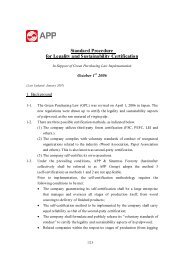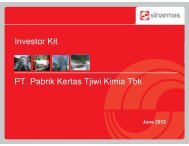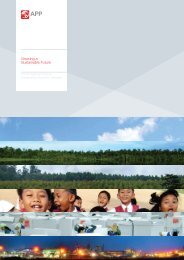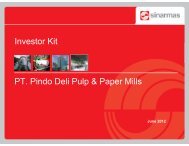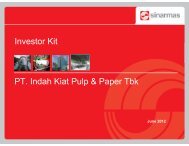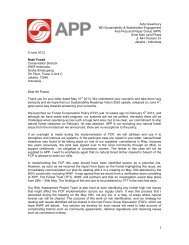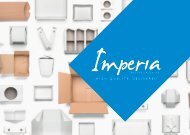APP Sustainability Report 2008-2009 - Asia Pulp and Paper
APP Sustainability Report 2008-2009 - Asia Pulp and Paper
APP Sustainability Report 2008-2009 - Asia Pulp and Paper
Create successful ePaper yourself
Turn your PDF publications into a flip-book with our unique Google optimized e-Paper software.
Sustainable Products<br />
Sustainable Products<br />
Electricity consumption per tonne of product<br />
was 831 kWh/AD tonne in <strong>2008</strong> <strong>and</strong> 824<br />
kWh/AD tonne in <strong>2009</strong>. Comparisons with<br />
IFC / World Bank st<strong>and</strong>ards are not possible<br />
since there are no specific st<strong>and</strong>ards for<br />
the amount of electricity consumed per AD<br />
tonne for recycled paper.<br />
Table 30 - Stack Air Emissions<br />
Parameter <strong>2008</strong> <strong>2009</strong> Local St<strong>and</strong>ard (mg/m 3 )<br />
SO 2<br />
14.99 19.20 250<br />
NO 2<br />
102.57 17.30 300<br />
Particulate 12.34 28.89 50<br />
Table 31 - Ozone Depleting Substances<br />
(kg) <strong>2008</strong> <strong>2009</strong><br />
R-134 A 95 122<br />
R-22 2,530 2,747<br />
R-12 14 81<br />
Water<br />
Water Usage <strong>and</strong> Wastewater Discharge<br />
Quality<br />
Annual water intake from the adjacent<br />
Ciujung River was essentially identical in<br />
<strong>2008</strong> <strong>and</strong> <strong>2009</strong>, at 12.3M m 3 . Raw water<br />
usage per tonne of product was 10.0 <strong>and</strong> 9.8<br />
m 3 /AD tonne of paper, respectively.<br />
The mill operates three wastewater<br />
treatment plants, the latest of which was<br />
commissioned in <strong>2008</strong>. The combined<br />
system, which consists of anaerobic followed<br />
by aerobic digestion stages, significantly<br />
improves the mill’s wastewater quality, in<br />
comparison with our aerobic-digestion-only<br />
systems, <strong>and</strong> the methane gas generated is<br />
to be fired in our boilers so it can contribute<br />
to the mill’s energy requirements. This<br />
installation was the first of <strong>APP</strong>’s CDM<br />
projects. There was an approximately 8 per<br />
cent increase in the volume of wastewater<br />
discharged from Indah Kiat Serang mill<br />
between <strong>2008</strong> <strong>and</strong> <strong>2009</strong>, from 10.3M m 3<br />
to 11.1M m 3 . The increased wastewater<br />
discharge reflects increased production of<br />
“white” grades, which require slightly more<br />
water usage. This translates into wastewater<br />
discharges of 8.4 m 3 /AD tonne <strong>and</strong> 8.8 m 3 /<br />
AD tonne, respectively, which compares<br />
favourably with World Bank / IFC Guidelines<br />
of 10 m 3 /AD tonne for recycled mills without<br />
de-inking. The differential between raw<br />
water input <strong>and</strong> wastewater discharge<br />
volumes is mainly due to evaporative losses.<br />
Local wastewater discharge st<strong>and</strong>ards were<br />
tightened in <strong>2009</strong>, when the mill’s third<br />
wastewater plant was brought on-stream.<br />
Table 29 - Wastewater Discharge Values<br />
Key Parameters<br />
The mean value of COD discharges (i.e. from<br />
all plants) was above the new limit, reflecting<br />
a need to improve the performance of<br />
the two older plants to match that of the<br />
new one. The mill’s effluent discharges are<br />
still generally above the World Bank / IFC<br />
Guideline values for recycled fibre mills,<br />
without de-inking.<br />
River Water Quality<br />
The quality of river water downstream of<br />
Serang mill is influenced by other industrial<br />
<strong>and</strong> domestic discharges upstream of<br />
Indah Kiat Serang, evident in water quality<br />
monitoring readings being frequently<br />
in excess of regulatory st<strong>and</strong>ards at the<br />
point where raw water is drawn. However<br />
Indah Kiat Serang’s wastewater discharge<br />
parameters are generally in compliance<br />
with relevant st<strong>and</strong>ards, as a result of the<br />
large wastewater treatment plant capacity,<br />
integral with our manufacturing processes.<br />
Emissions to Atmosphere<br />
Stack Emissions <strong>and</strong> Ambient Air Quality<br />
Monitoring<br />
Local air-quality emission st<strong>and</strong>ards were<br />
revised during the period covered by this<br />
<strong>2008</strong> / <strong>2009</strong> report <strong>and</strong> is now stricter than<br />
Indonesian national st<strong>and</strong>ards. Mean values<br />
for air quality emissions monitoring are given<br />
below, <strong>and</strong> show that Indah Kiat Serang was<br />
still able to deliver full compliance with the<br />
new st<strong>and</strong>ards. The mill air emission were<br />
estimated to be close to zero kg/AD tonne<br />
throughout <strong>2008</strong>-<strong>2009</strong>. Ambient air quality<br />
monitoring results also indicated that Indah<br />
Kiat Serang mill operations did not affect the<br />
air quality of the surrounding areas.<br />
Ozone Depleting Substances<br />
Indah Kiat Serang had taken measures<br />
in reducing their consumption of Ozon<br />
Depleting Substances <strong>and</strong> replace them<br />
with more environmentally friendly<br />
refrigerants. The table on this page shows<br />
the consumption of refrigerants that were<br />
included as ODS.<br />
Waste Management<br />
Non-hazardous Waste<br />
Post-consumer waste generates significant<br />
quantities of rejects when re-pulped –<br />
typically 6 percent to 10 percent of the<br />
input weight – comprising plastics, envelope<br />
windows, staples, rags <strong>and</strong> other general<br />
debris. This pulper – <strong>and</strong> screening-rejects<br />
material, plus wire from bales of pulp <strong>and</strong><br />
wastepaper, <strong>and</strong> rejects from the mill’s deinking<br />
plants, represents the major waste<br />
for disposal from Serang mill. Quantities of<br />
these solid non-hazardous wastes generated<br />
were 150,347 tonnes (140,103 tonnes of<br />
rejects <strong>and</strong> 10,244 tonnes of wire) in <strong>2008</strong><br />
<strong>2008</strong> Local St<strong>and</strong>ard <strong>2009</strong> Local St<strong>and</strong>ard <strong>2008</strong> <strong>2009</strong> WB / IFC St<strong>and</strong>ard<br />
(mg/l) except ph<br />
(kg/ADT) except pH<br />
BOD 57.42 96 60.82 90 – 100 0.48 0.54 0.2<br />
COD 221.58 250 204.87 175 – 300 1.85 1.80 4.0<br />
TSS 56.75 92 67.57 80 – 100 0.47 0.59 0.3<br />
pH 7.36 6 – 9 7.25 6 – 9 6 – 9<br />
<strong>and</strong> 150,602 tonnes (137,896 tonnes of<br />
rejects <strong>and</strong> 12,706 tonnes of wire) in <strong>2009</strong>.<br />
Virtually all rejects are disposed of on-site<br />
in two rotary-kiln incinerators. Baling wire<br />
is sold for recycling. Some self-employment<br />
opportunities are being provided to local<br />
villagers, who segregate plastics <strong>and</strong><br />
wire from the waste streams for on-site<br />
reprocessing into, for example, wire coat<br />
hangers, <strong>and</strong> for local craft use.<br />
No significant quantities of liquid nonhazardous<br />
wastes requiring off-site disposal<br />
were generated during <strong>2008</strong> <strong>and</strong> <strong>2009</strong>.<br />
Hazardous Waste<br />
The site’s hazardous (B3) waste comprised<br />
of boiler fly ash <strong>and</strong> bottom ash, <strong>and</strong> WWTP<br />
sludge. There was an 11.6 percent increase<br />
in the amount of solid hazardous waste<br />
generated, from 104,303 tonnes in <strong>2008</strong><br />
to 116,357 tonnes in <strong>2009</strong>. No significant<br />
quantities of liquid B3 wastes requiring offsite<br />
disposal were generated in either year<br />
since all waste oils were incinerated on-site.<br />
Boiler ash was sold to a licensed user for<br />
cement production, <strong>and</strong> used to improve the<br />
reactivity of the cement. Quantities were<br />
34,200 tonnes in <strong>2008</strong> <strong>and</strong> 51,900 tonnes in<br />
<strong>2009</strong>. Most of the Indah Kiat Serang WWTP<br />
sludge is disposed of on-site, in a licensed<br />
Table 32 - Range of major solid process wastes<br />
hazardous (B3) waste l<strong>and</strong>fill. A small but<br />
increasing quantity – currently 3 percent – of<br />
separated, primary (biologically inactive)<br />
sludge is now being re-incorporated in some<br />
low-grade, packaging-medium papers. Total<br />
sludge quantities were 67,000 tonnes in<br />
<strong>2008</strong> <strong>and</strong> 61,500 tonnes in <strong>2009</strong>.<br />
No spills occurred in Indah Kiat Serang during<br />
<strong>2008</strong> <strong>and</strong> <strong>2009</strong>.<br />
Environmental Expenditures<br />
Total expenditure on the treatment <strong>and</strong><br />
disposal of waste at Indah Kiat Serang was<br />
US$5,532,000 in <strong>2008</strong> <strong>and</strong> US$5,590,000<br />
in <strong>2009</strong>. An additional US$58,200 in<br />
<strong>2008</strong> (US$51,100 in <strong>2009</strong>) was spent<br />
on maintaining the external audit <strong>and</strong><br />
certification of Serang’s ISO 14001:2004<br />
Environmental Management Systems,<br />
<strong>and</strong> the associated ISO 9001:<strong>2008</strong> Quality<br />
Management Systems.<br />
Plant Efficiency <strong>and</strong> Plant<br />
Improvement Programmes<br />
A project to recover methane from anaerobic<br />
wastewater treatment for use as a fuel for<br />
the mill was successfully completed in <strong>2009</strong>,<br />
<strong>and</strong> in the process of validation for eligibility<br />
for the sale of its carbon credits under the<br />
UNFCCC Clean Development Mechanism<br />
(CDM). This is the first CDM project for<br />
<strong>APP</strong>, <strong>and</strong> for the pulp <strong>and</strong> paper industry<br />
worldwide.<br />
Other mill improvement programme<br />
highlights commencing or continuing in years<br />
<strong>2008</strong> / <strong>2009</strong> included:<br />
• Reduced fibre consumption (of LBKP<br />
<strong>and</strong> low-grade pulp) by improving fibre<br />
recovery <strong>and</strong> upgrading equipment. The<br />
result is a 17 percent reduction in virgin<br />
pulp consumption on certain grades.<br />
• Reduced energy consumption for<br />
production of liner <strong>and</strong> corrugating<br />
medium by upgrading equipment. The<br />
result is reduction of steam consumption<br />
by 10 percent <strong>and</strong> electricity consumption<br />
by 2 percent.<br />
• Reduced fresh water consumption in stock<br />
preparation by 72 percent, by improving<br />
valve controls, recycling cooling water <strong>and</strong><br />
adding alarms to alert overflows.<br />
• Reduced overall site water consumption<br />
by recycling backwash water to the raw<br />
water treatment facility.<br />
• Reduced moisture content of coal by<br />
building a coal yard roof. This has a<br />
projected energy savings of 3 percent to<br />
5 percent.<br />
(tonnes) <strong>2008</strong> <strong>2009</strong> Re-use <strong>and</strong>/or disposal pathways<br />
Non-hazardous waste<br />
Wire 10,224 12,706 Sold to third party<br />
Rejects 140,103 137,896 Disposal to on-site rotary kiln incinerators<br />
Hazardous waste<br />
Sludge 67,000 61,500 Disposal through third party companies<br />
Fly ash <strong>and</strong> bottom ash 34,200 51,900 Sold to cement plant<br />
[EN 8, EN 9, EN 19, EN 20, EN 21]<br />
[EN6, EN22, EN23, EN26, EN30]<br />
40 <strong>APP</strong> 08/09 <strong>Sustainability</strong> <strong>Report</strong> <strong>APP</strong> 08/09 <strong>Sustainability</strong> <strong>Report</strong> 41



